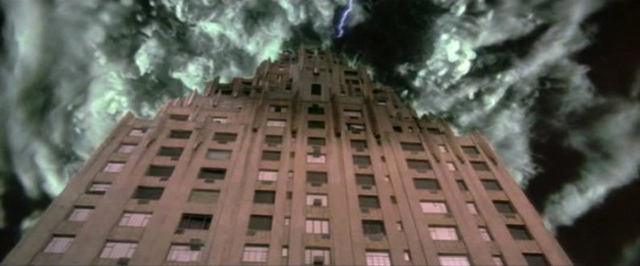The sad news that actor, screenwriter, and director Harold Ramis passed away yesterday has unsurprisingly resulted in a wave of cinematic nostalgia, with #ghostbusters trending globally on Twitter and seemingly everyone, at least in this office, talking about films such as Groundhog Day, Caddyshack, and National Lampoon’s Vacation.
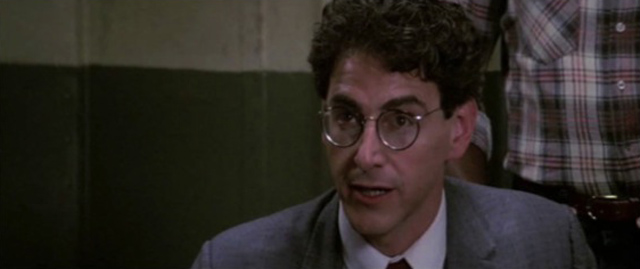
This newly intensified attention to Ramis’s career seemed not only like a good opportunity to point out that Ghostbusters and Groundhog Day are both absurdly great films — and there has never been a better time to watch both of them in honour of Ramis’s incredible humour and creativity — but also to make the case that Ghostbusters contains one of the most architecturally interesting subplots in recent film history.
It really gets going about two-thirds of the way through. So beware: there may or may not be spoilers ahead.
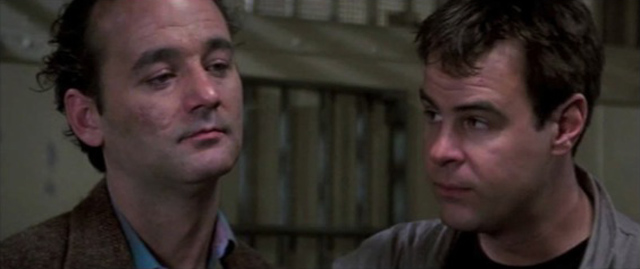
Roughly two-thirds of the way through the film is one of my favourite scenes in the whole movie. Even as an eight-year old kid, seeing this in the theatre with my family, I was blown away by this particular scene — I might even say it’s one of the earliest reasons I got interested in architecture.
So what happens? Having just been arrested for contaminating all of New York City with an explosive pulse of supernatural energy — in reality, a pink tide of hot dog-eating ghosts and cab-driving poltergeists set free by a fantastically annoying EPA agent who stupidly shuts down their protective storage grid — the Ghostbusters find themselves behind bars.
But, lo!
Dan Aykroyd’s character has — of all things — an entire roll of blueprints and structural diagrams along with him, a voluminous sheath of construction documents that, for whatever reason, have made it into the jail cell with him.
Aykroyd’s character — a heavily mortgaged former Columbia University professor named Dr. Ray Stantz — walks over to a nice wooden table in the center of the room, where he unrolls his architectural documentation as if there could be nothing so natural or expected.
The other Ghostbusters — and everyone else present, whether locked up for murder or public drunkenness, assault or Grand Theft Auto — gather round.
It’s time to discuss a very unusual building.

After all, as viewers of the film will already be aware, the Ghostbusters at this point are desperate.
They need to figure out exactly what’s going on, why the ghosts they have been chasing all over the city are seemingly accumulating around one particular high-rise — 55 Central Park West — and how that very same building, where Bill Murray’s love interest both lives and undergoes a scantily-clad act of demonic levitation, might be attracting so much supernatural energy.
What’s with the building?
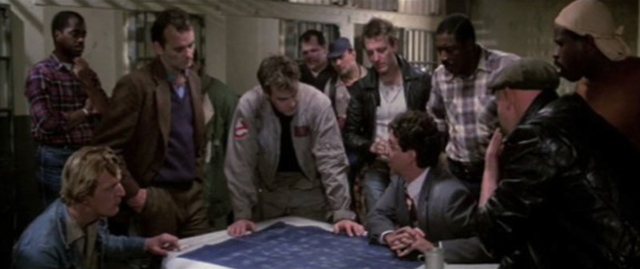
What is so awesome about this for architecture fans is that the ensuing discussion foregrounds the built environment of New York City in a way that few other plot lines could justify.
The action of the film all but stops, it becomes an entirely dialogue-driven scene, and we zero in on some blueprints to discuss the surreal and unexpected methods of construction that had been used while putting the building together.
This unironically thrilling scene thus crosses genres in a way that architectural academia would be wise to learn from — offering a moment of sustained architectural interpretation in the guise of popular entertainment — in the process, bringing spatially interesting questions to an audience of millions.
In any case, there they all are as Dr. Ray Stantz leads them through the paperwork — and what he has to say is incredible.
This is not really a building at all, he suggests — or, rather, it is not just a building.
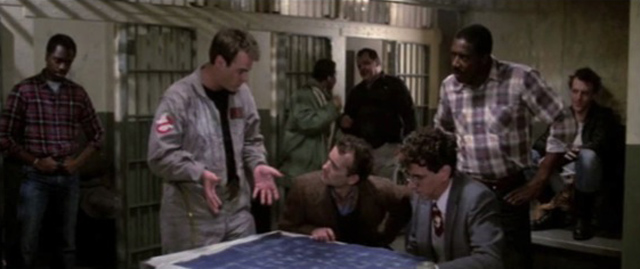

Look at this ironwork, he exclaims! Look at these strange, non-structural geometries, these laces and bracings of metal where metal has no reason to be! And think of the weird tale of the architect himself, he adds, nearly breathless now, lording over these papers and diagrams, gesturing at structural details and describing the occult leanings of a mythic figure named Ivo Shandor.
Shandor, you see, deliberately designed the high-rise to serve as a kind of antenna, an acupuncture point for the supernatural, a vortex for all that is dead and wants to live again.
It is an axis between worlds, disguised as a luxury apartment complex.
When demons appear inside refrigerators and eggs spontaneously fry on a kitchen countertop — as they do — it is all just part of the architect’s literal plan, his floor plans shaped such that more than mere humans could take up residence within.
There is thus something uncanny about the building, something poisonous or odd in its very hallways and ironwork — something that British architectural writer and novelist Will Wiles would call a malign interior, when a building contains “rooms that derange, abduct and kill.”
After all, isn’t this the basic idea of all haunted house — or haunted high-rise — tales, that architecture itself can become a spatially malevolent source of great evil and malicious intentions?
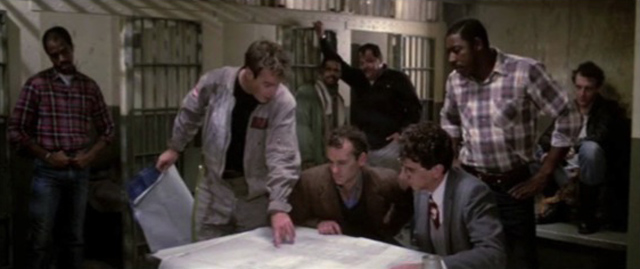
But that’s by no means all! No way, my friends — because things go haywire soon thereafter, once the Ghostbusters are freed from jail and they make their strange ascent up the stairwell of 55 Central Park West, huffing their ghost-blasting proton packs up stair after exhausting stair until they reach the summit of this haunted monolith, this magic mountain of rock on the western edge of Central Park.
Skipping over some details, the top of the building has exploded by now, you see, and a previously secret stairway leading up to the roof has been revealed amidst the smoke and burnt furniture — and it is no ordinary roof to which this staircase leads.
Forever fixing in my mind the idea that architectural ornament can be both utterly magic and other-worldly, the Ghostbusters find that the ornate masonry on the peak of this tower is not what it seems: all along, the elaborately carved gargoyles have hidden actual, living gargoyles and the building’s tomb-like pinnacle is actually a vast Babylonian TV set through which ancient gods might someday walk. Though, for now, it’s actually just a woman who looks like something out of Flashdance calling herself Zuul.
She leaps around and prances across the stonework, and the entire building, at this point, is just a giant mindfuck for any 8-year old to see: it’s a skyscraper almost geological in form, crawling with lightning strikes, its statuary self-animating to run through the city streets of their own free will.
Cracking open with a roiling atomic flash to reveal pastel atmospherics of another world, the building takes center stage in every possible way, bursting into the minds of the audience at the most dramatic point and absorbing all of the narrative tension the way the fictional building itself was meant to absorb ghosts.
Ghostbusters thus inadvertently becomes one of the most interesting architectural films of the last few decades, with its admittedly absurd and childish introduction to building analysis, but an introduction nonetheless. I know that I, for one, never really looked at buildings the same way again — and, looking back today, I suppose, at least in some small part, I owe a heart-felt architectural thanks to Harold Ramis.
